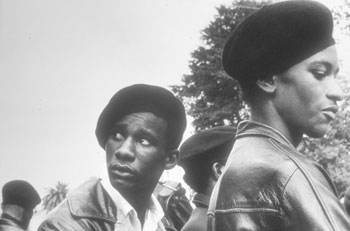Recalling the Black Panthers’ East Bay heyday
BAM mounts reprise of blockbuster 1968 photo exhibit; PFA film series provides moving counterpoint
![]()
| 02 April 2003
| |  Black Panther guards at a Free Huey rally, Oakland, August 25, 1968. Ruth-Marion Baruch photo |
In March 1966, two young activists who had met at Oakland’s Merritt College were arrested on Telegraph Avenue just south of the Berkeley campus after reciting an anti-war poem written in the voice of a black draft resister. Bobby Seale and Huey Newton — who that fall would found the Black Panther Party for Self Defense — were there that day to try to reach students who cared passionately about the draft and the ongoing conflict in Vietnam.
How swiftly the Black Panthers captured the imagination not only of Berkeley students but of people around the country is evident in the way campus news was reported just two years later. Detailed accounts of the trial of Huey Newton on charges of murdering an Oakland police officer dominated the pages of the Daily Californian throughout the summer of 1968. (Typical headlines: “Panthers Set Rally for Huey,” “Newton’s Advice to His White Friends,” “Pseudo-Scientific Testi-mony in Huey Trial,” and, in response to an op-ed piece, “Panthers’ Column Was ‘Pig Crap.’”) That fall, the UC system was rocked by a standoff between students and the UC Regents, led by Gov. Ronald Reagan, over Social Analysis 139X, a Berkeley political-science course that featured Black Panther Eldridge Cleaver, author of the best-selling book Soul on Ice, as a guest lecturer.
It is this remarkable time and a movement it gave rise to that the Berkeley Art Museum illuminates in “The Black Panthers 1968,” an exhibition of 45 photographs, on display through June 29, taken by Ruth-Marion Baruch and her husband, Pirkle Jones. Both were associated with the Peace and Freedom Party, and through that connection learned of the Panthers’ program. “Slowly we began to comprehend how severely maligned they were by all the communications media,” Baruch later wrote. “The urge to correct this injustice grew rapidly within me.”
The two Bay Area photographers — Baruch a European-born Jew who faced discrimination in America, Jones a white man from Louisiana whose family had witnessed lynchings — set out to reveal “the feeling of the people” and to share their images with the public through a major exhibition. Baruch first approached the de Young Museum of San Francisco, asking whether it would be willing to mount a show on the Black Panthers, then asked the Panthers themselves if they would consent to be photographed. Approvals secured, on July 14, 1968, Baruch and Jones landed, cameras in hand, at a “Free Huey” event in Oakland’s DeFremery Park.
Many photographers before and after captured paramilitary images of the Panthers. Baruch and Jones, too, shot images of young men in leather jackets and black berets — their faces revealing a humanizing variety of expressions and attitudes (hopeful, doubtful, intent, idealistic, pensive). They also documented Panther women as well as interested members of the black community, notable in their ordinariness (a man carrying a sleeping baby, a girl in prim white suit with a black handbag, women in ’60s paisley or African-print robes). The series grew from there as the two attended public events held by the Panthers throughout the summer. More intimate portraits — including several of Huey Newton in jail — were possible once they’d returned with the first set of prints and the Panthers liked what they saw.
“For me the thesis of the exhibit is the optimism of that moment, the feeling that young people really were making a difference,” says BAM curatorial associate Stephanie Cannizzo, who organized the current exhibit in the museum’s Theater Gallery. The period documented could hardly have been more charged, she notes. Only three months before Baruch and Jones began their project, Martin Luther King, Jr. was assassinated (on April 4, 1968, 35 years ago this week); Robert Kennedy’s death came two months later. Across the world, 1968 was also the year that students and workers staged a general strike in France, students were killed during Mexico City demonstrations, and the U.S. military launched the second Tet offensive in Vietnam.
At Berkeley, students organized a controversial “Vietnam Commencement” honoring those who refused to serve in southeast Asia, and held rallies in Sproul Plaza (one of them, depicted in the exhibit, appears on this page) around the Panther cause. The campus’s proximity to Oakland, where the Black Panther Party was founded, “can’t be overemphasized,” says Joshua Bloom, director of the Social Movements Project at the campus Institute for the Study of Social Change. The Panthers’ politics “were very much designed” to bring together the struggles of disenfranchised urban blacks and left-wing student politics, especially the anti-war movement, he says.
When the de Young Museum, after much controversy and hesitation, exhibited 123 images from the Panther project in the winter of 1968-69, record crowds attended — more than 100,000 people in all. The exhibit later traveled to Studio Museum in Harlem, Dartmouth College, and UC Santa Cruz. Thirty-five years later, many of those images are getting an East Bay homecoming, in conjunction with three evenings of historical and contemporary films at Pacific Film Archive.
Links:

